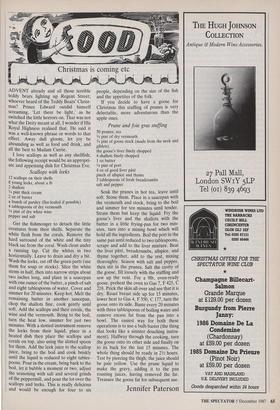ADVENT already and all those terrible teddy bears lighting up
Regent Street; whoever heard of the Teddy Bears' Christ- mas? Prince Edward outdid himself screaming, 'Let there be light,' as he switched the little horrors on. That was not what the Deity meant at all, I wonder if His Royal Highness realised that. He said it was a well-known phrase or words to that effect. Away dull gloom, let joy be abounding as well as food and drink, and all the best to Madam Currie.
I love scallops as well as any shellfish; the following receipt would be an appropri- ate and appetising dish for Christmas Eve.
Scallops with leeks
12 scallops on their shells 8 young leeks, about a lb 2 shallots
1/4 pint thick cream
2 oz of butter a bunch of parsley (flat-leafed if possible) 4 tablespoons of dry vermouth
1/4 pint of dry white wine
pepper and salt
Get the fishmonger to detach the little creatures from their shells. Separate the white flesh from the corals. Remove the hard surround of the white and the tiny black sac from the coral. Wash clean under a running tap. Cut the whites in two horizontally. Leave to drain and dry a bit. Wash the leeks, cut off the green parts (use them for soup or stocks). Slice the white stems in half, then into narrow strips about two inches long, and place in a saucepan with one ounce of the butter, a pinch of salt and eight tablespoons of water. Cover and simmer for 20 minutes. Keep hot. Melt the remaining butter in another saucepan, chop the shallots fine, cook gently until soft. Add the scallops and their corals, the wine and the vermouth. Bring to the boil, turn the heat low, simmer for just two minutes. With a slotted instrument remove the leeks from their liquid, place in a heated dish then place the scallops and corals on top, also using the slotted spoon for them. Add the leek juice to the scallop juice, bring to the boil and cook briskly until the liquid is reduced to eight tables- poons. Pour in the cream, bring back to the boil, let it bubble a moment or two, adjust the seasoning with salt and several grinds of the peppermill, and pour the lot over the scallops and leeks. This is really delicious and would be enough for four to six people, depending on the size of the fish and the appetites of the folk. If you decide to have a goose for Christmas this stuffing of prunes is very delectable, more adventurous than the apple ones.
Prune and foie gras stuffing
50 prunes; tea
1/4 pint of dry vermouth
1/4 pint of goose stock (made from the neck and giblets) the goose's liver finely chopped 4 shallots finely chopped 1 oz butter
1/4 pint of port
4 oz of good liver pâté pinch of allspice and thyme 3 tablespoons of fresh breadcrumbs salt and pepper
Soak the prunes in hot tea, leave until soft. Stone them. Place in a saucepan with the vermouth and stock, bring to the boil and simmer for ten minutes until tender. Strain them but keep the liquid. Fry the goose's liver and the shallots with the butter in a little frying-pan for two min- utes, turn into a mixing bowl which will hold all the ingredients. Boil the port in the same pan until reduced to two tablespoons, scrape and add to the liver mixture. Beat the liver pate, breadcrumbs, allspice, and thyme together, add to the rest, mixing thoroughly. Season with salt and pepper, then stir in the prunes. Salt the cavity of the goose, fill loosely with the stuffing and sew up the vent. For a 91b, oven-ready goose, preheat the oven to Gas 7, F 425, C 218. Prick the skin all over and see that it is dry. Roast breast side up for 15 minutes, lower heat to Gas 4, F 350, C 177, turn the goose onto its side. Baste every 20 minutes with three tablespoons of boiling water and remove excess fat from the pan into a bowl. The easiest way for both these operations is to use a bulb baster (the thing that looks like a sinister douching instru- ment). Halfway through the cooking, turn the goose onto its other side and finally on to its back for the last 15 minutes. The whole thing should be ready in 21/2 hours. Test by piercing the thigh; the juice should be pale yellow. Use the prune liquid to make the gravy, adding it to the pan roasting juices, having removed the fat. Treasure the goose fat for subsequent use.
Jennifer Paterson










































































 Previous page
Previous page